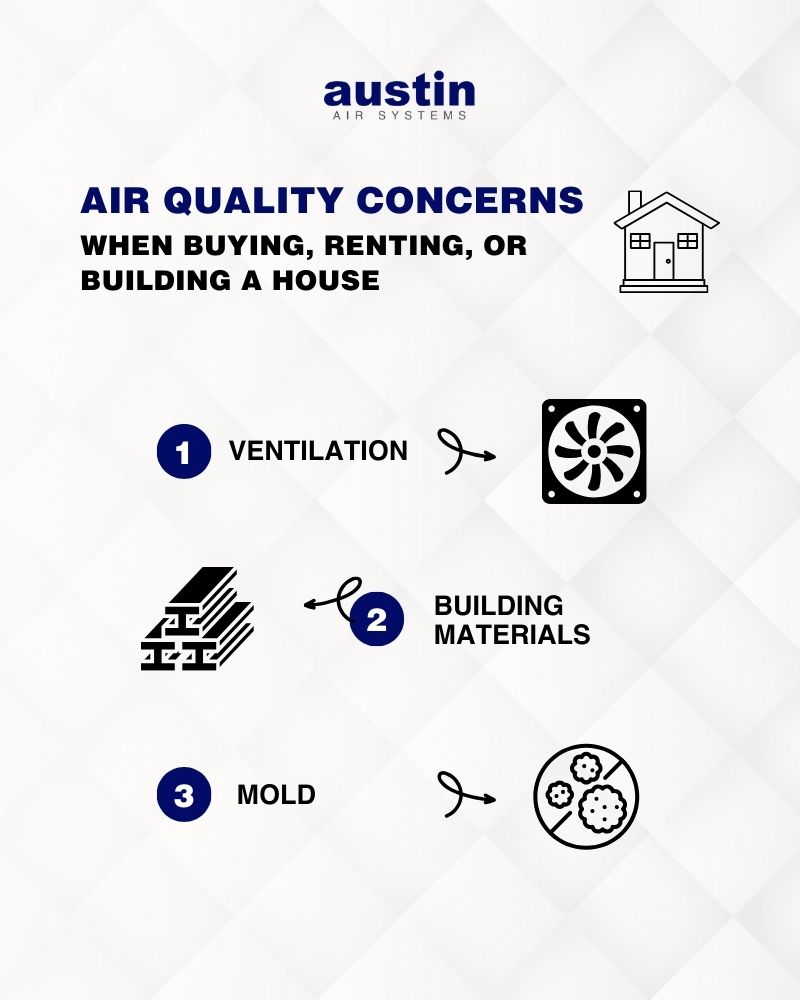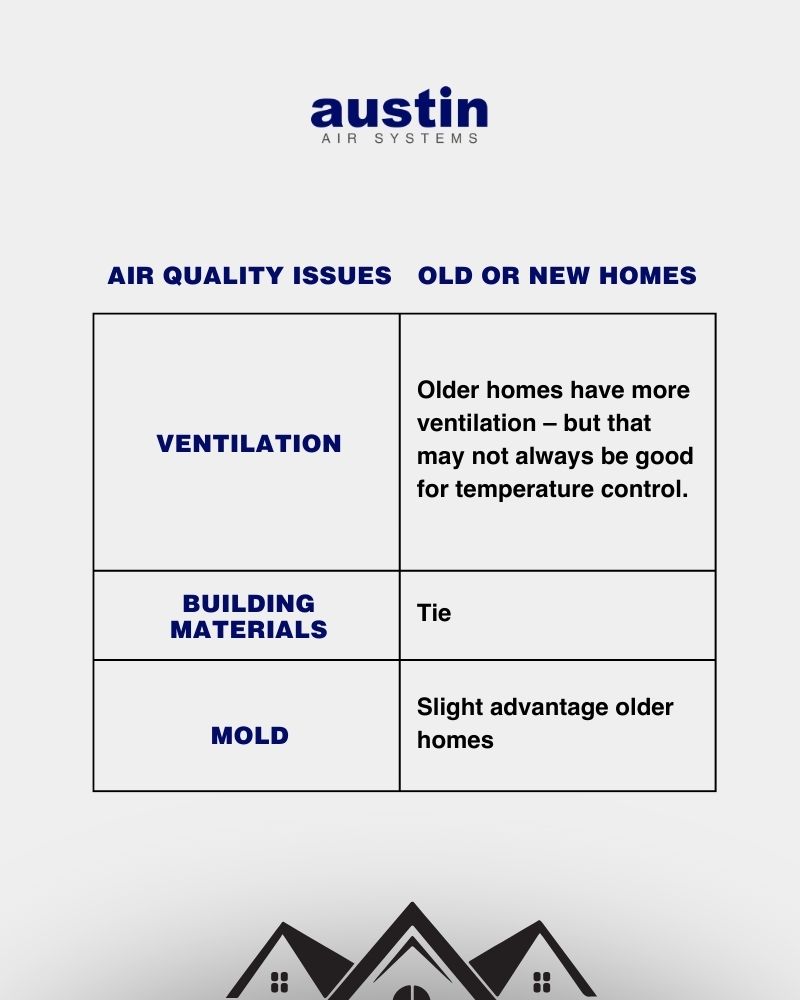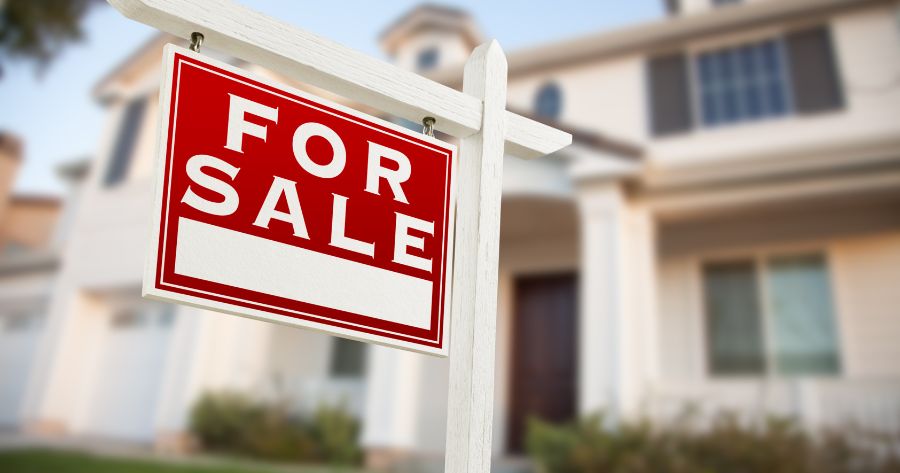It’s on the horizon, that time of year when the real estate industry is booming with FOR SALE signs and open houses galore. Rental properties are also an especially hot commodity this time of year. Additionally, with winter weather gone contractors are busy with building new properties. All in all, the real estate industry is about to be very busy.
In the pursuit of finding the perfect home, prospective buyers and renters often focus on aspects like location, layout, and aesthetics. A critical factor that might not always receive the attention it deserves is indoor air quality. Whether you’re considering purchasing/renting an old home with character or building a brand-new one from scratch, understanding air quality issues is essential for ensuring the health and well-being of your household.
The air we breathe within our homes profoundly impacts our well-being, especially for vulnerable groups like children prone to asthma, individuals with allergies, or those who are immunocompromised. Overlooking air quality can lead to unforeseen health complications. There are plenty of horror stories of individuals who neglected this vital aspect and fell ill in their supposedly dream homes. As you envision your future in a new dwelling, safeguarding against such risks becomes not just prudent but essential for long-term health and happiness.
In this blog post, we’ll delve into the key air quality considerations for both scenarios and also discuss some best practices for buyers and sellers.

Old Home vs. New Build
Older homes possess a unique charm and character that can be irresistible to many buyers. However, they often come with their own set of challenges when it comes to indoor air quality. But while building a new home offers the opportunity to customize features to your preferences, it also presents its own set of air quality considerations.
Don’t feel too daunted – some of the issues mirror each other and we’re here to do the deep dive for you.
Ventilation
Ventilation is essential for maintaining indoor air quality by removing pollutants, controlling moisture levels, regulating temperatures, diluting odors, and promoting occupant health and comfort. Incorporating proper ventilation strategies into building design and operation is key to ensuring a safe and healthy indoor environment for occupants.
OLDER HOMES: One positive of older buildings is that the construction isn’t usually as air tight as modern builds, which allows for more ventilation. Additionally, older homes may lack adequate, dedicated ventilation systems, leading to stagnant air and indoor pollutants buildup. Consider installing mechanical ventilation systems or incorporating natural ventilation strategies during renovations to improve indoor air circulation.
NEW BUILDS: You can’t assume the designs for a new build will automatically have what you need. Work with your builder to design an efficient ventilation system that meets industry standards for air exchange rates. Incorporate features such as energy-recovery ventilators or whole-house filtration systems to enhance indoor air quality and reduce the risk of airborne pollutants.
VENTILATION ADVANTAGE: Older builds have a bit of an advantage here when it comes to air flow but full disclosure: this isn’t ideal for temperature control and comfort.
Harmful Materials
Unfortunately, both old and new homes have unique air quality issues tied to the materials used to build them. Harmful materials inside a new home can significantly impact indoor air quality by releasing pollutants into the air through a process known as off-gassing. Off-gassing occurs when volatile organic compounds (VOCs) and other harmful chemicals evaporate from building materials, furnishings, and household products into the indoor environment.
TWO OF THE LEADING HARMFUL MATERIALS IN OLDER HOMES ARE:
LEAD PAINT: Lead-based paint was commonly used in homes built before 1978. When this paint deteriorates, it can release lead dust into the air, particularly during renovations or repairs. Exposure to lead can lead to neurological and developmental issues, especially in children. Consider testing for lead paint and taking necessary precautions if purchasing an older home.
ASBESTOS: Homes built before the 1980s may contain asbestos in insulation, flooring, or ceiling tiles. When disturbed, asbestos fibers can become airborne and pose serious health risks, including lung cancer and mesothelioma. Before purchasing an older home, it’s crucial to have it inspected for asbestos, and if found, consult with professionals for safe removal.
SOME OF THE MOST COMMON, HARMFUL MATERIALS IN NEW CONSTRUCTION INCLUDE:
BUILDING MATERIALS: Newly constructed homes often contain volatile organic compounds (VOCs) emitted from paints, adhesives, and other building materials. These chemicals can contribute to indoor air pollution and cause respiratory irritation. Opt for low-VOC or zero-VOC products and allow sufficient time for off-gassing before moving in.1
COMPOSITE WOOD: Pressboard, plywood, and particleboard commonly used in new construction can release formaldehyde, a known carcinogen, into the air. Choose building materials with low formaldehyde content or consider alternative options to minimize exposure.
MATERIAL ADVANTAGE: This can only be determined on a case by case basis. It might not be all doom and gloom. For example, many older spaces have been free of lead paint for decades. On the other hand, there are carpenters who won’t touch composite wood or use anything other than low or zero-VOC paints and stains. You can have a lot of control with this issue based on the furnishings, flooring, and paint you choose after moving in.
Mold
Normal occupant activities and behaviors, such as cooking, bathing, and drying clothes indoors, can introduce additional moisture into the indoor environment. Without proper ventilation and moisture control measures, these activities can exacerbate mold and mildew problems over time in both old and new homes – but the factors contributing to the presence and severity of mold and mildew can differ between the two.
HERE ARE THE MOLD-SPECIFIC ISSUES THAT PLAGUE OLDER BUILDINGS:
WATER INTRUSION: Over time, older homes may develop structural issues such as roof leaks, foundation cracks, or plumbing problems, which can allow water to infiltrate the building envelope. Persistent moisture exposure can promote mold and mildew colonization on surfaces such as walls, ceilings, and floors.
AGING BUILDING MATERIALS: Older homes may contain materials that are more susceptible to moisture damage, such as plaster, wood, and untreated drywall. These porous materials provide an ideal substrate for mold and mildew growth if moisture levels are not properly controlled.
HISTORICAL RENOVATIONS: Renovations and repairs conducted over the years in older homes may have been performed without proper moisture management practices. Improper sealing, insulation, or drainage solutions can exacerbate moisture problems and contribute to mold and mildew issues.
LACK OF MAINTENANCE: Older homes may have deferred maintenance or neglect, increasing the likelihood of moisture-related issues going unnoticed or unaddressed. Failure to promptly repair leaks or mitigate water damage can result in widespread mold and mildew infestations. Attics are a common place where mold occurs for this reason and should be included in the inspection.
SOME OF THE MOLD HAZARDS FOR NEW BUILDINGS ARE BELOW:
CONSTRUCTION MOISTURE: During the construction process, new homes can be exposed to moisture from materials, building activities, and weather conditions. Improper drying techniques or accelerated construction schedules may result in trapped moisture within building components, creating an environment conducive to mold and mildew growth.
INDOOR HUMIDITY: As previously mentioned, tighter building envelopes and energy-efficient construction practices in new homes can reduce natural ventilation and airflow. In addition to causing stagnant air, this can potentially lead to elevated indoor humidity levels. Excessive humidity, combined with inadequate ventilation, create the conditions favorable for mold and mildew development, particularly in tightly sealed spaces.
MOISTURE FROM NEW MATERIALS: Newly installed building materials, such as concrete, drywall, and lumber, may contain moisture that needs time to dry out completely. If enclosed within the building envelope before drying adequately, these materials can contribute to elevated indoor humidity levels and moisture-related issues.
MOLD ADVANTAGE: It’s another toss up and buyer beware! There are no federal guidelines for mold the way that there are for lead paint. BUT in many states, mold is considered a “material defect” which sellers are required to disclose. In New York State, a law went into effect last year requiring sellers to share the mold history of a house.
Selling, Renting, Buying, or Building a Home?
As we’ve demonstrated, indoor air quality issues can plague both older homes and new builds. In older homes, factors like poor air exchange and water intrusion over time can contribute to subpar air quality or mold growth. Conversely, in new builds, tightly sealed construction methods aimed at energy efficiency can trap pollutants indoors, including VOCs from fresh paint, flooring, and furniture. Additionally, off-gassing from building materials and inadequate ventilation systems can exacerbate indoor air quality concerns, highlighting the need for proper ventilation and air quality management in both old and new residential structures.2
If you’re in the process of selling, buying, or building a home, or looking for a rental, you may be wondering: how can I protect myself? Or my investment?
The best thing you can do, particularly if you are worried about an issue like mold, is to be honest.
- BUYERS: Make an offer contingent upon an inspection and have an expert specifically seek out mold.
- SELLERS: Don’t try to hide any material defects – inspectors will usually find the issue and the sale will fall through anyway, with precious time wasted.
- BUILDERS: Check with your construction manager about specifics like air flow, ventilation, etc. to ensure these air quality control methods are included in the design.
- RENTERS: Read all lease paperwork for the procedure for ending a lease early if there is an issue and check with state laws about landlord requirements.
You can hear more about air quality issues and real estate, with some specifics on mold, in the “Austin On The Air” Podcast with guests Mark and Rachael Kibbe, business partners and realtors at Keller Williams Realty.
Finally, the best thing you can do for peace of mind is invest in Austin Air purifiers for the home. Air cleaners reduce the presence of toxins, pollutants, and allergens to improve air quality from an “acceptable” baseline to truly healthy.

REFERENCES
1 Suzuki N, Nakaoka H, Hanazato M, et al. Indoor Air Quality Analysis of Newly Built Houses. Int J Environ Res Public Health. 2019 Oct 28;16(21):4142. doi: 10.3390/ijerph16214142.
2 Indoor Air. (December 2023). New York State Department of Health. https://www.health.ny.gov/environmental/indoors/air/.
